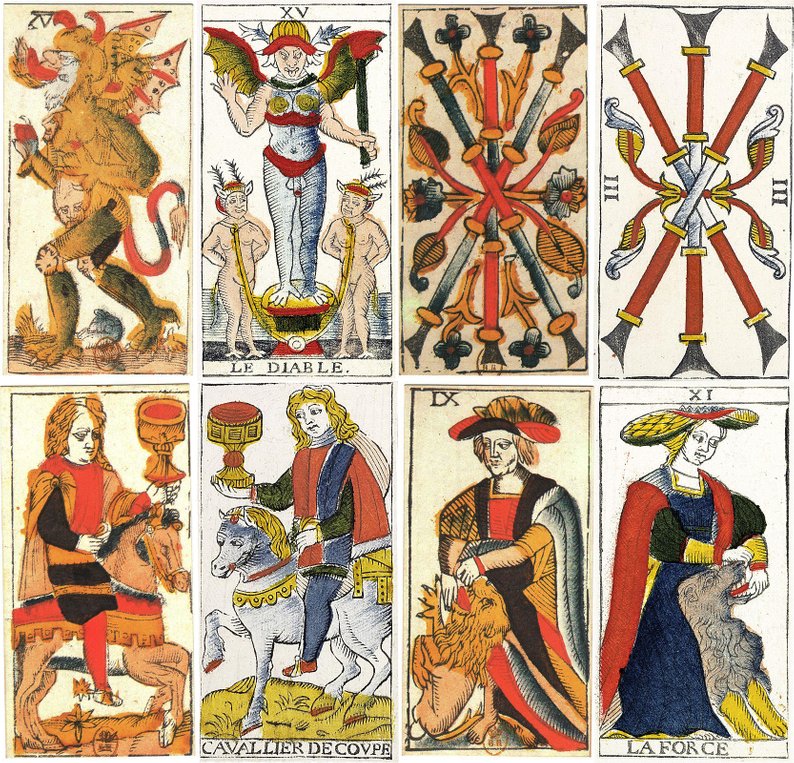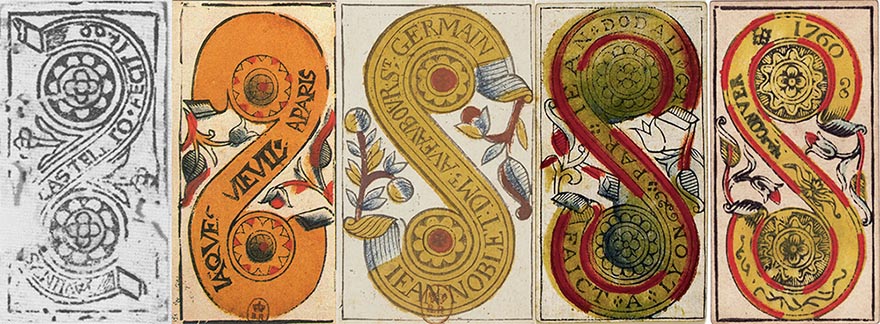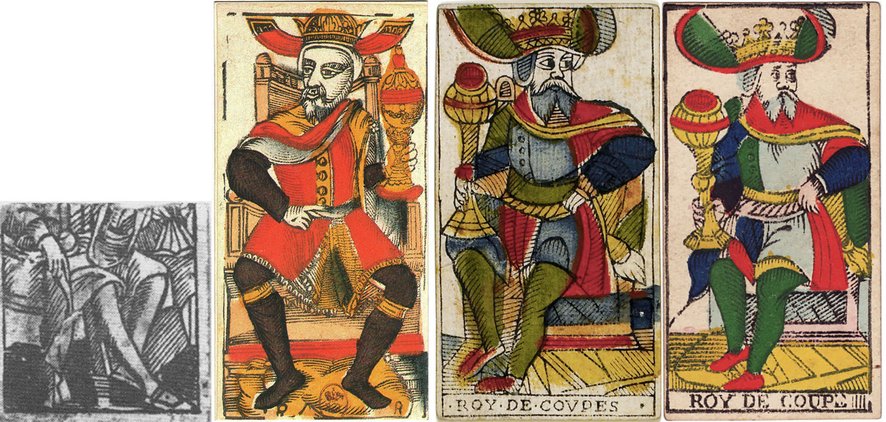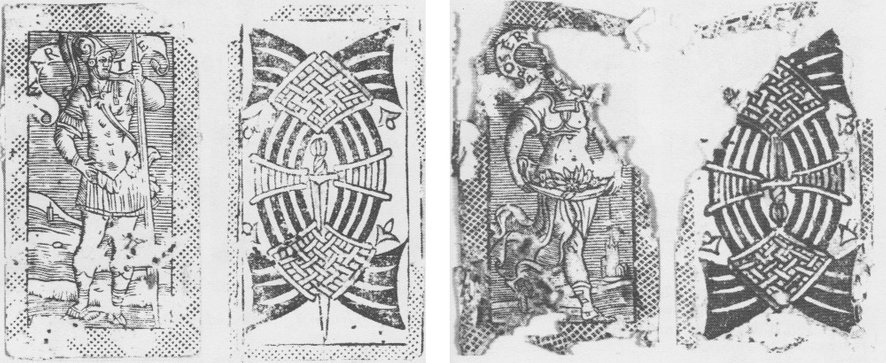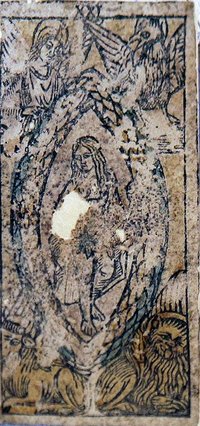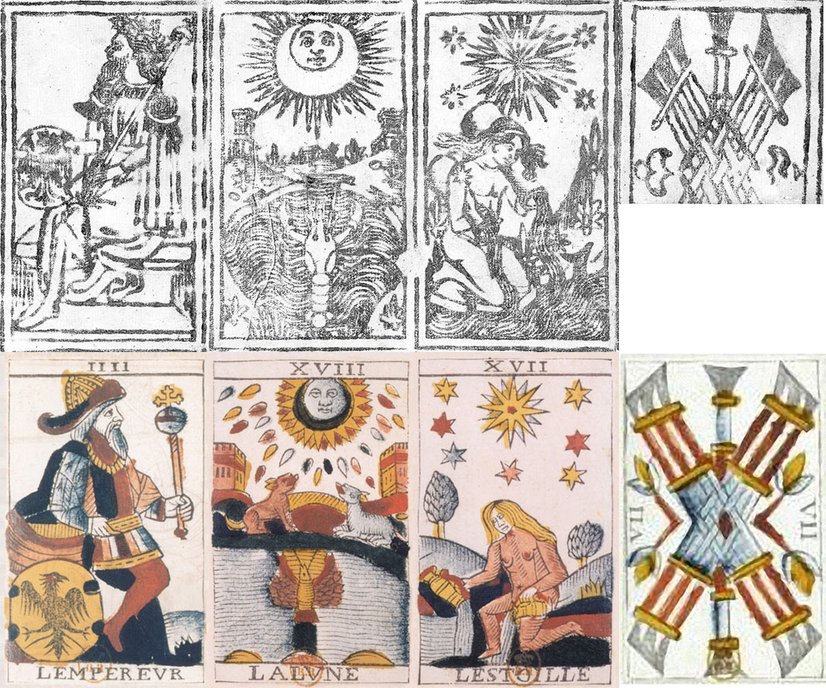THE TAROT WHEEL
ANCESTORS OF THE MARSEILLE TAROT
When I talk below about the first deck of any type, it is in reality the oldest deck known deck of which one or more copies survived time. Card decks are used for playing. Cards get lost and paper wears out. When decks could not be used anymore to play with, they were thrown away. This is one reason why copies of old decks are rare. And this is especially true in France, where on the 19th October 1701, the King Louis XIV (the Sun King) declared a tax of 18 deniers on all card decks (including Tarot decks) and ordered the destruction of all existing woodblocks (except, under certain conditions, those who served for making Tarot decks, called Tarrot in the text. Actual stocks of cards could be sold until the end of the year, after that date all new cards should bear the tax stamp. A copy of this royal decision is conserved in the French National Library and can be found on their website on the address http://gallica.bnf.fr/ark:/12148/btv1b8602065h/f1.image. To avoid paying this tax, special export versions were produced, sometimes under fictive names, like the Tarot of Jean Dodal that was probably produced by Jean Payen.
The oldest (and only known) deck in France that has many things in common with the Marseille Tarot is the Tarot created by a certain Jaques Vievil in Paris, somewhere at the end of the first half of the 16th Century. But differences between the Marseille Tarot and the deck created by Jaques Vievil there are:
- The sceneries on the trumps cards numbered 14 to 19 and 21 are different, or they have important differences
- The trump cards on the deck of Vievil don't bear names
- The pip cards of the Vievil deck are never numbered
- The floral decorations on the pip cards are more developed in the Vievil deck
- There are some differences in the order of the trumps, the trumps 7 and 8 shifted places as well as the trumps 9 and 11. However, these might be printing mistakes
- Most cards that have the same scenery, show mirrored pictures, when we compare each other
The next figure illustrates some of these differences:
Apart from these differences, the cards look a lot alike. Many typical scenes for the Marseille Tarot cards, like the Lovers, the Chariot and the World are also present in the Tarot of Jaques Vievil, although differences in details exists. Except for the more developed floral decorations on the Vievil deck, the pip cards are very much the same and also the figures on the court cards have almost the same (but mirrored) poses. It seems evident that both decks are tapping from the same source of inspiration. The difference in style is because Jaques Vievil and the first designers of the Marseille deck (like Jean Noblet in Paris and Nicolas Rolichon in Lyon), did not simply copy older decks, they were partly inspired by the same source and partly by other sources. Apparently, Jaques Vievil had access to a Bolognese deck. Because the Italian decks were not numbered, he misinterpreted at least one of them. His Moon is almost identical to the Sun on the Bolognese deck. As a result, Noblet and Vievil created different decks, with differences between them, and with differences when comparing them with older decks
Having accepted that the Tarot of Jaques Vievil and the Marseille Tarot are using at least partially the same sources of inspiration, the question is now, what were these older sources, and where and when were they created?
Let us have a look at the cards found in the well in the Milanese Sforza castle, mentioned on the page about the transition period between the Italian Trionfi cards and the Marseille Tarot. Most cards are dated to the 17th or 18th Century. The cards dated to the 17th Century have a same style of card back as the 1600 Tarot of Bologna mentioned on the same page. Two cards can be recognized as trumps (the World and the Sun), ten fragments can be recognized as court cards, and the remaining 30 fragments belong to pip cards. The first person reporting about these cards is a certain Novati, in an article that appears in 1908 in the “Bulletino dei Civici Musei Artistici ed Archeologico di Milano (Anno III)”. The next year, he publishes another article about the cards in the journal “Il libro e la Stampa”. The articles are mentioned in 1966 by Gertrude Moakley in her book about the Visconti cards, and in 1980 and 1981 by Michael Dummett in a series of articles in “the Journal of the International Playing-Card Society”. Finally Stuart Kaplan reports about the cards in “The Encyclopedia of Tarot, part II” on the pages 289 to 296.
Kaplan shows photo's of all 42 fragments with Italian suit symbols, he does not show the cards having French suit symbols. The oldest fragments can be dated to the end of the 15th Century, and the youngest ones seems originating from the 18th Century. The cards belong to different decks. The cards are placed in eleven groups, from probably the oldest cards to the maybe youngest.
Group I consist of only one single card, a Two of Coins, with a size of approximately 48 x 93 millimeters. It looks exactly as the Two of Cups of the Marseille Tarot (see the figure here below). On the banner, linking both coins together, is written PAVLINVS ….. CASTEL.....TO FECIT 1499, where the points replace unreadable characters. The back of the card does not show any pattern.
According to the research of Novati, around 1500 there lived a card maker in Milan who was called Paolino da Castelletto. References have been found to him dating from 1494, 1508 and 1513. It is very plausible that this card was produced by him. Remember that the French King Louis II d'Orleans took Milan in 1499 and 1500, and that his army stayed there for several years. Very probably, copies of these printed cards went to France with the returning French troops.
In the following figure, this card is compared with the Two of Coins of several TdM type decks. Next to the card found in the Sforza Castle we have from left to right in chronological order cards from the decks of Jaques Vievil, Jean Noblet, Jean Dodal and Nicolas Conver:
We remark that except for the floral decorations, who are different in every deck, the cards are very similar, including the way the coin symbol is represented. The main difference is that in the Tarot the Marseille (the 3 cards on the right side), the scenery is mirrored when looking at the older cards (Sforza castle and Vievil). We will look a bit closer at the reason for this mirroring when we deal with the internal structure of the Tarot decks.
The next card, here below, is a fragment, it seems that the card has been ripped in two parts before it was thrown in the well. We can recognize the illustration as the King of Cups (the person is sitting and has a cup in one of his hands). The card has a width of 57 millimeters. In comparing the style of this card with other known cards, it has been dated to the end of the fifteenth or the beginning of the sixteenth Century. In the next figure we compare this card, again with some TdM style cards.
The cards presented are from the decks of Jaques Vievil, Jean Dodal and Nicolas Conver. Again we see the same mirrored position of the cup in the hands of the King. Vievil has another position for the feet, but on the Marseille Tarot they are clearly the same, but again mirrored. The fragment looks more similar to the TdM cards than when compared with the card of Vievil.
All other cards are dated after the French left Milan. The third group consist of nineteen cards, fourteen numbered cards and five court cards. Twelve of the cards, including all court cards, have been ripped in two. According to Novati, the cards have probably been produced in Venice in the 16th Century. Michel Dummett is convinced that they have been produced in Milan, in the 16th or maybe the 17th Century. The cards belong to nine different decks of the same card printing press, for this reason alone it is likely that they were produced in or near to Milan. 5 Fragments are of court cards and 14 fragments of pip cards. 8 of the pip cards are Swords, 4 are Cups and 1 each of Batons and Coins. The suit symbols are presented similarly as on the Marseille Tarot, but they cannot be attributed to one single style. The 9 of Swords presented in the figure here below differ from each other. The card on the left looks like the older TdM style cards (including Vievil) and the card on the right is identical to the youngest of the TdM style decks. The ten of Cups is identical in decoration (but mirrored) as the Vievil card, but different from the TdM decks who lack the floral decoration on this card. The court cards are much harder to identify. Three of them have a different position than on the TdM and Vievil court cards. One looks like a mirrored TdM Page of Cups, the other is probably a Page of Coins. It cannot be seen if the card is mirrored or not. Two of the pip cards (a nine of Swords and a ten of Cups) are not mirrored compared to the TdM style decks, for the others it cannot be determined. The size of the cards is approximately 57 by 102 millimeters. None of these cards have names or numbers written on the face of the cards. The back size of the cards presents Roman Gods and Heroes, with their name written on a banner above the figure. They are very similar to a Tarot of Bologna deck conserved in the French National Library and dated to approximately 1600 , http://gallica.bnf.fr/ark:/12148/btv1b105109607/f1.planchecontact.r=tarot.langEN
In the above figure, the 9 of Swords from two different decks, one with the God of War Mars on its back side and the other with the Goddess of Spring Proserpine. Remark that on the card of the Mars deck the ninth sword is pointing downwards and on the Proserpine deck upwards. Five other cards are also odd numbered Swords, and we remark the same variation. Three times the last sword is pointing downwards and two times the last sword is pointing upwards. On the Cups and the court cards, the right side is always up.
Another group of six cards is again dated by Novati to the 16th Century, but Michael Dummett has arguments to date them to the 17th Century. The cards have a typical Italian format, with the height twice the width, 68 by 135 millimeters. All cards are apparently from the same deck, with on the back Cupido (without a blindfold) shooting his arrows at the hero Ruggiero, who is standing in front of a naked Angelica. This story was part of the poem Orlando Furioso, written in 1516 by Ariosto. However, the most interesting card is a trump card, the World.
In the above figure we compare the World card from the Sforza castle with the same cards from Nicolas Rolichon, Jean Dodal and Jean Payen (all Type I Marseille decks). The cards are simply identical, although the card of the Sforza castle deck does not have a name written below the scenery. It also has a more elaborated drawing style (compare for example the lions). On the card found on the Sforza castle the ox and the lion have legs, on the French cards these details have been removed to make place for the name of the card. The image shown here is a modified copy of an original photo taken by Ross Caldwell, who was kind enough to authorize me using his photo. The original picture can be found on the address http://www.rosscaldwell.com/images/mondo/sfozesco.jpg
In the same group as the World card, there are five numbered cards, the five, seven and nine of swords, the six of coins and the eight of batons. The cards are again in every detail identical compared to the decks from Jean Payen and Jean Dodal. Especially the deck of Jean Payen is identical in the slightest details. There are differences in the floral decorations with all other TdM style decks. The only difference between the deck of the Sforza caste when compared to Payen and Dodal is that on the TdM decks the swords and batons have numbers written on the side of the cards, on the eight of batons the number even replaces the floral decoration. It seems very probable that the cards from the Sforza castle are older than the Type I Marseille cards and that a copy of the same deck as has been found in the Sforza castle has served to created this specific TdM style.
The cards from the groups five to ten are all very to the TdM decks, but different in details. Group 6 has five cards from one single deck, with a size of 64 by 117 millimeters. There are one court card and four pip cards. The pip cards (swords and coins) are all numbered, but the Seven of Coins is spelled IIV and the Six of Swords IV. The court card is the Knight of Swords, the looks closely like the last generation of TdM cards, but it does not have its name mentioned on the card. Kaplan writes, in his Encyclopedia of Tarot, that the deck is probably from Bologna in the 18th Century.
The cards in group eleven have a size of 61 by 110 millimeters. There are one trump card (the Sun), one court card (the knight of Cups), and one pip card (the Four of Batons). The back of the cards have the same diamond shaped structure as is typical for the French decks at the beginning of the 18th Century, for this reason, Michael Dummett attributes the deck the same age. Again, although there are differences in details, the cards have many features very similar to the decks of Rolichon, Dodal and Payen.
The Sforza castle is not the only source of old printed decks. The so-called Cary sheet, dating from approximately 1500 and conserved in the Cary Yale Library, has also many features in common with the Marseille decks. The Seven and Eight of Batons are identical to the Marseille pattern, and the many Trumps appearing on this sheet have many points in common with the Marseille Tarot.
In the next figure, we have some cards belonging to the Cary sheet, an uncut sheet found inside the cover of an early 16th Century book, compared to the deck of Jean Noblet, the oldest Tarot deck with the Marseille pattern. Six cards on the Cary sheet appear complete, the Popess, the Emperor, the Empress, the Moon, the Star and the Conjurer (Magician). From fourteen other cards, only fragments are present. The sheet is dated to +1500. Although not identical, the trump and pip cards have a strong resemblance with the Marseille Tarot. Some cards are different, like the Devil, but the basic structure is there. We also remark again that some cards are mirrored compared to the cards of Jean Noblet.
The conclusion seems clear (but who am I?), the Marseille Tarot has its roots in Northern Italy, it is definitely not a French invention. Similar patterns, as we find later on the French Marseille Tarot, existed already some 150 to 200 years before Jean Noblet in Northern Italy. In fact, it was and still is a standard Italian pattern. Not all cards we found in the Sforza caste are that old, but they fill important gaps between the handcrafted Trionfi decks and the printed Marseille Tarot, and most important of all, they are a very convincing evidence for its Italian origin.
